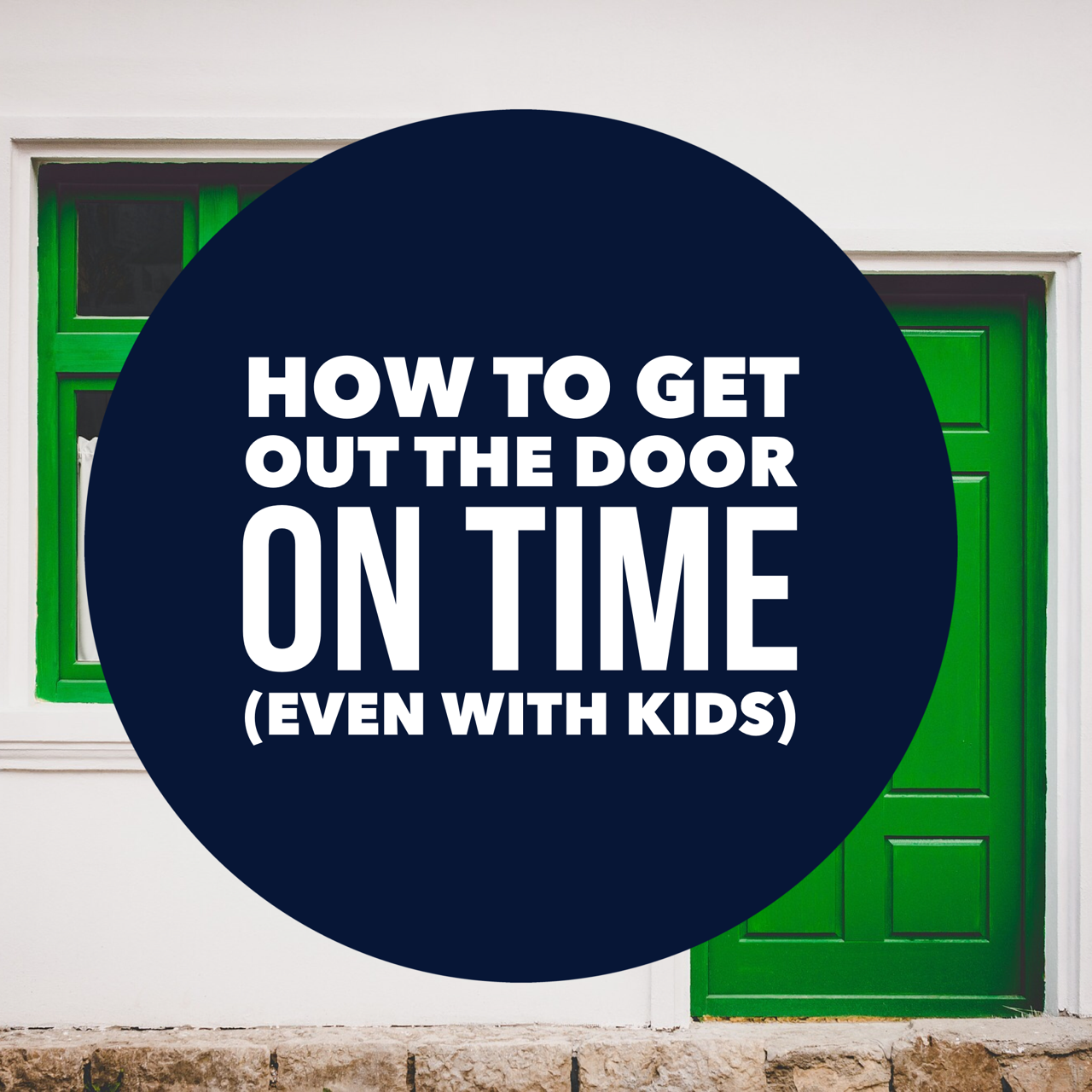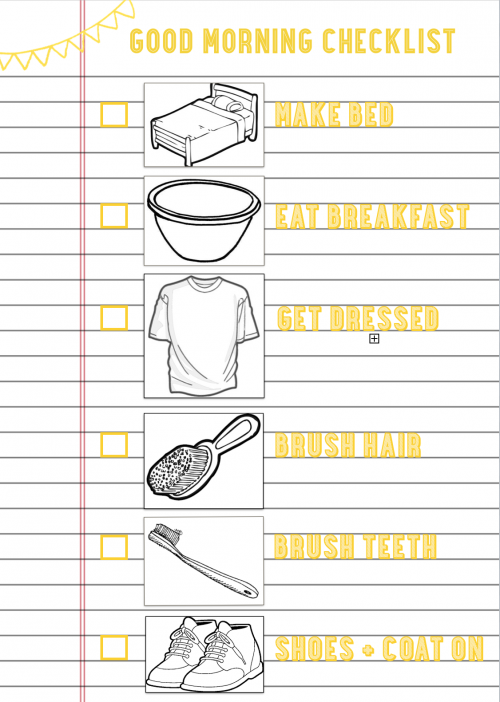How to get out the door on time (even with kids)

I still remember when my son was young and getting into battles with him to leave the park, a friend’s house or even home. I’d start nice and patient; then I’d kind of be bribing him with some idea about what we were doing next; and I mostly always ended up with a very sad boy.
I’m happy to report that by my second child – and with my training as a Montessori teacher – I no longer got into these battles. I was much clearer, had positive ways to encourage cooperation, and provided support for them if they became upset.
So I would love to share some ideas with you how to get out of the house on time.
WORKING WITH YOUR CHILD
One thing I learned from the wise Alfie Kohn is that there is a very big difference when look at the situation from the perspective “how can I work with my kids”. Rather than trying to bribe them (“You’ll get you a sticker if you…”) or threaten them (“You’ll go to your room if you…”), you can be their guide.
Leaving the house, we then look from the lens “how can I help my child to be prepared to leave?” Here are some ideas to get you started.
Slow down the pace
When dealing with toddlers and young children, rushing is not the preferred option. They seem to just dig their heels in even more and things take twice as long.
One day when you are not in a hurry, it is a useful exercise to actually time how long it takes to do everything to get out of the house. Then allow an extra five minutes on top in case someone cannot find their gloves or another emergency arises, and you are sure to have a more relaxed start to the day and more cooperative children.
I highly recommend the book “In Praise of Slow“. What I learned is to practise going slow most of the time. Then when there are inevitably times you do have to rush, you will find you have more cooperative companions. For example, you could say, “Normally we take our time to get dressed, but today we need to catch a bus and then train and I don’t want us to miss our connection.”
Prepare the environment
Just as a Montessori classroom is prepared in a way that everything has a place, the work looks appealing, and the furniture is child-size, we can set up areas of our home so that our children can have more independence.
For example, in the hallway, it is lovely to have:
- hooks for hanging coats and scarves
- a basket for gloves and hats
- a place for storing shoes
- a place to sit to get shoes on and off
Then the area is attractive and functional for getting out the door (and for when we get home too).
Teach skills
“Help me to do it myself” encapsulates the Montessori spirit. This may mean choosing clothing that the child can manage themselves, for example, velcro on shoes or a safe way to hold on to the handrail while going up and down stairs, etc.
And we can break down the skill they are learning into small steps, for example, putting on their own coat:
- Place the coat down on the floor
- Stand by the hood or label
- Put your hands in the sleeves and flick up and over your head
- The coat slides down and on
Try not to interrupt your child
Just as tackling a tricky subject with your partner or boss requires some planning, timing is everything with your child. It can be frustrating to be interrupted in the middle of a phone call or whilst trying to read something.
Children also prefer not to be interrupted if they are busy with something. Allow them to finish what they are doing before you interrupt them, for example, to tell them to use the potty or to get ready to leave.
Some children also respond to being forewarned, “It is leaving time in 5 minutes. You can choose to start finishing up your game or you can put it somewhere so you can finish it when we get back.”
Move closer to your child
Getting down to their level and making eye contact also helps get their attention more than calling out from across the other side of the room.
Allow time for processing
Once you have sought cooperation from your child, it is worth counting slowly in your head (not aloud) to 10 before repeating yourself. Children need to process what we have said and, while we think they are ignoring us, they are just taking longer to process the information.
SOME OTHER IDEAS
1. Use a checklist
Some kids love checklists, even before they can read. So I have made a Good Morning Checklist for you to make it easy for you. Click here to download and print the checklist.

2. Give a choice
“Would you like to put on your coat or shoes first?”
3. Get them to think
“What do we need to do before we leave?” OR “Where are your shoes kept?”
4. Describe the problem (without judgement) and let them work out the rest
“I see you have bare feet and we are about to go outside”
5. Use one word instead of a long explanation
“Shoes” (if they are to put on their shoes)
“Light” (as a reminder to turn off the light)
“Plate” (if they have forgotten to take their plate to the kitchen)
6. Whisper
This is a surprising way to get their attention.
7. Write a note
“Please don’t forget me!” (taped to a pair of shoes)
(even if they can’t read, they are sure to ask you what it says)
8. Use a clock or timer to beat
“Let’s see if we can get ready before the big hand gets to the 12/before the beeper goes off”
If you have more than one child in the family, to avoid sibling rivalry, I do not recommend seeing who can be fastest. There is sure to be war. Instead you can see how fast you can be as a family and the fastest people help the slower ones so you are all working together.
IF YOU RUN INTO DIFFICULTIES…
Remember, the adult is in charge
1. Do not get into a power struggle.
2. Remain calm.
3. Once you have asked (allowing time for them to process your request), be gentle but firm and get on and make it happen. This may mean picking up your child to leave, so your child knows that you are consistent.
If your child becomes upset, give them a cuddle, name their feelings. But, as hard as it is, keep moving forward…
You could say “You really wish you could stay at home”OR “You really wish you didn’t have to put your coat on” as you are waling towards the door.
DESCRIBE
When there is success, be sure to show your appreciation for your child’s cooperation by describing what they have done.
“I see a girl who is ready to go out and play in the park. You have your shoes on, your coat done up, and your mittens and hat will keep you warm. I like how you got yourself ready while I packed the bag.”
OLDER CHILDREN
For a younger child it’s more about providing encouragement, simple choices, making it fun etc to engage cooperation. But what about when they are getting older and still don’t help to leave the house?
I had an email about a 5 year old who would be easily distracted from getting ready. In this case, it sounds more like they are getting their parents to pick up the rope for them. That is, the child is handing the responsibility for getting dressed or out the door to their mum or dad.
Sometimes we think it will help to keep giving them cues, for example, “now you need to put on your shoes” etc. But whilst talking them through things can help, it still keeps the responsibility with the parent.
Some ideas instead:
- They could work together to come up with something that would work for both of them
- Use the checklist so it’s the checklist not the parent that has to tell them what is next
- The parent can let natural consequences step in, eg, if the child is not ready, they can go to school in their pyjamas (just warn the school maybe beforehand so they can support at that end on arrival)
- Get the parent to keep busy herself – her role is just to support, not make it all happen.
Our role as a parent is to take responsibility for having clean clothes available, healthy meals and support when needed, but – at 5 years particularly – the child should be able to mostly manage this themselves with just a little help.
LAST TIPS
- I love sleep. But I really recommend waking up half an hour earlier. Even better if it’s before the rest of the family wakes up – time to yourself to shower, get dressed, and be ready to help the others if they need it.
- Fill their emotional bucket first thing in the morning – snuggle in bed, read books, give lots of hugs and tickles. Those lovely minutes spent connecting with your child will pay off in cooperation during the morning routine.
- Prepare the night before – it can help to pack lunches, lay out possible clothes choices, check the weather etc the night before. Rise and shine and you will be ready to go.
I hope these ideas are useful! And if you have any stories to share (successes or otherwise!), drop me an email. I love learning from each others’ experiences.

Simone Davies has more than 20 years’ experience as an AMI Montessori educator. Simone is the author of “The Montessori Toddler” and co-author of “The Montessori Baby” and “The Montessori Child” books, comprehensive guides to raising children in a Montessori way. She currently runs parent-child Montessori classes in Amsterdam at her school Jacaranda Tree Montessori. She also has a popular blog, instagram and podcast “The Montessori Notebook” and is mother to two young adults.